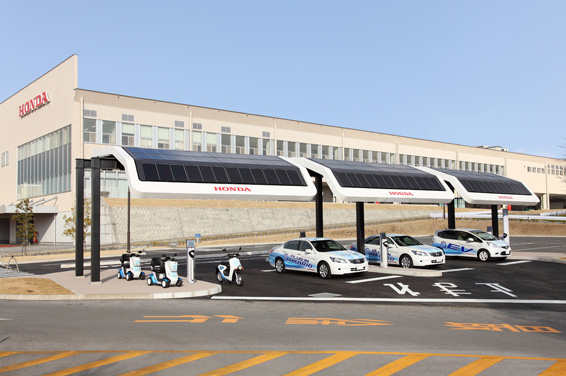
Honda Motor Co., Ltd. announced its plan on the ongoing cooperation with Kumamoto Prefecture on Electric Vehicle Testing Program for next-generation personal mobility products, including electric vehicles (EVs), plug-in hybrid vehicles, electric scooters and electric carts. The specifics of the testing program, testing vehicles and solar-powered charging stations have also been revealed at Honda’s Kumamoto Factory.
Conducted in real-world urban transportation environments, the program will focus on motorcycles, automobiles and power products based on electromotive technologies. The comprehensive program will also use advanced communications & telematics and solar-powered charging technologies to explore future forms of personal mobility and their potential of carbon dioxide emissions reduction.
Major objectives of the Electric Vehicle Testing Program
On August 5, 2010, Honda and Kumamoto Prefecture entered into a comprehensive agreement to perform testing of next-generation mobility within the prefecture (agreement period: August 2010-March 2013). Based on this agreement, Honda has already begun testing the Monpal ML200 electric cart with the cooperation of Kumamoto City starting in October 2010. Additional testing programs will take place in Kumamoto City, Minamata City, Aso and Amakusa areas to further help realize a low-carbon mobility society in the future. The program will study the following:
The practicality and convenience of electromotive technology featured on next-generation personal mobility products, including Honda’s electric vehicles and plug-in hybrid vehicles, the EV-neo electric scooter and the Monpal ML200 electric cart.
The effectiveness of solar power generation and other renewable energy sources in helping to realize a low-carbon mobility society.
The potential of next-generation personal mobility to enhance the QOL (quality of life) of residents in local communities.
Earlier on December 15, 2010, Honda announced its Electric Vehicle Testing Programs in the United States (Torrance, California) and with Saitama Prefecture on December 20. In addition to Japan and the United States, Honda is also considering the possibility of conducting a similar program in China.
Electric Vehicle Testing Program in Kumamoto Prefecture
Kumamoto Prefecture, its cooperating municipalities, the Kumamoto Industrial Federation, Kumamoto University, Kyushu Electric Power Co., Inc. and Honda have formed a Next-Generation Mobility Testing Program Implementation Committee, which will explore the potential QOL benefits of next-generation personal mobility. To help contribute to the expansion of EVs and plug-in hybrid use, the committee will also explore future programs and locations within Kumamoto Prefecture. The following are the program objectives for each city:
Kumamoto City
Evaluate the QOL benefits of sharing Monpal ML200 electric carts at facilities for senior citizens using quantifiable data:
Shared use among residents of senior citizens’ home located near the heart of the city.
Personal use of Monpal to senior citizens for commuting to a suburban health and welfare facility.
Short-term rental to residents and/or visitors to senior care facilities.
Rental program of EV-neo scooters to local residents and tourists to study its convenience of use and benefits. In addition, provide EV-neo to high school students to familiarize them with motorcycles and EVs as well as study their use in their school route.
Identify optimal locations for EV charging stations on prefectural facilities and other properties.
Minamata City
Rental program of EV-neo scooters to local residents and tourists to study its convenience of use and benefits, and identify optimal locations for EV charging stations on prefectural facilities and other properties.
Aso area
Rental program of EV-neo scooters and plug-in hybrid vehicles to tourists to study its convenience of use and benefits.
Amakusa area
Study the convenience of use and benefits of EVs as local transportation on the island.
Electric Vehicle Testing Program vehicles
In addition to zero-emission electric vehicles, scooters and carts, the testing program will also include Honda’s plug-in hybrid vehicles, which combine a gasoline engine with two high-output electric motors.
Electric vehicle (EV):
Based on the popular Fit that is known for its compact, maneuverable body and superior utility, this vehicle features a coaxial motor and other electromotive technologies developed for the FCX Clarity fuel cell electric vehicle, combined with a Toshiba-produced lithium-ion battery. Charging with a 200-volt power source takes less than six hours, and vehicle driving range exceeds 160 km.
Plug-in hybrid vehicle:
Based on the platform of the Inspire mid-size sedan, this vehicle features a fuel-efficient 2.0-liter i-VTEC engine and two high-output electric motors, specially developed for this system. The vehicle can be operated in three drive modes: all-electric, gasoline-electric hybrid and engine drive modes. The lithium-ion battery is manufactured by Blue Energy, and the vehicle’s all-electric mode driving range is 15 to 25 km.
Electric Sccoter(EV-neo):
Honda made the EV-neo electric scooter available for lease today in Japan to companies that make short-range deliveries and also to individual business owners.
Electric Cart (Monpal ML200):
Firstly launched in 2006, this stylish, comfortable and easy-to-ride 4-wheel electric cart with great stability will also be used as a testing vehicle. The Monpal used in this testing program will add a recording device capable of storing a variety of vehicle operation and performance data.
Solar-powered charging station
Located inside Honda’s Kumamoto Factory in Kumamoto Prefecture, this charging station features a solar-powered generating system manufactured by Honda Soltec. Honda will use the station in combination with advanced communications & telematics to test a wide variety of program objectives.



